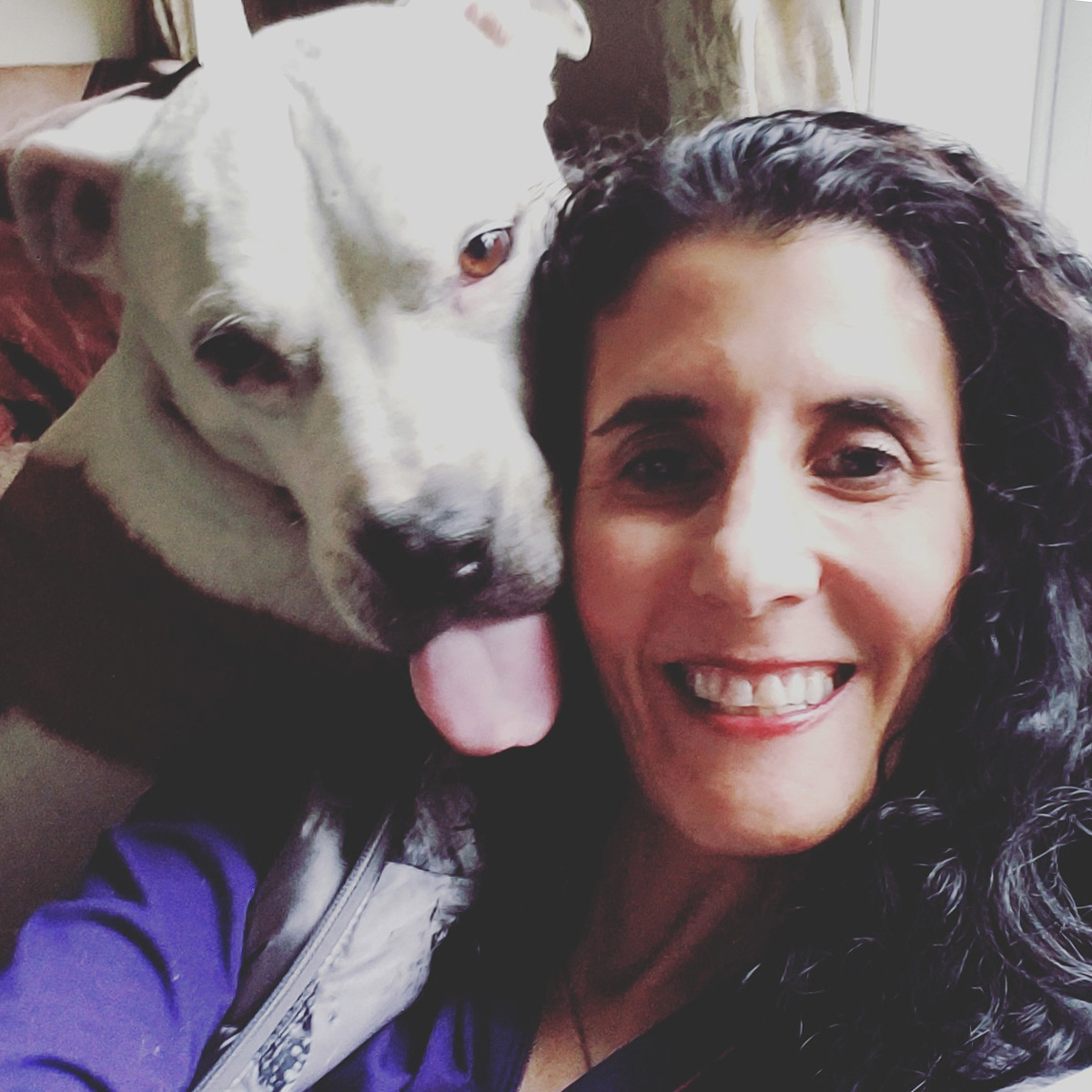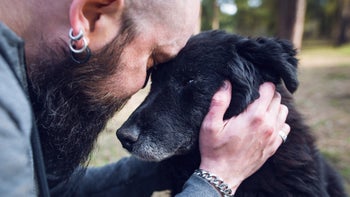
How to Calm Down Your Anxious, Stressed, or Hyperactive Dog
Key takeaways:
You can help manage your dog’s anxiety, stress, or extra energy by making sure they get enough physical and mental exercise, among other approaches.
If your dog’s anxiety or hyperactivity doesn’t get better with home remedies, ask your vet about other options.
Certain active dog breeds are more prone to anxiety than others. Herding breeds and sporting dogs, for example, may need more activity to use up their energy.
Table of contents
Have you ever noticed that some dogs can’t sit still, while others are comfortable as couch potatoes? Some dogs have anxious energy, and that may have to do with their breed. Certain dog breeds are more likely to experience hyperactivity, stress, and anxiety.
There are many ways to address anxiety, stress, and hyperactivity in dogs. In some cases, it’s enough to make sure they’re getting enough physical and mental stimulation. But there are other potential solutions.
Natural ways to calm an anxious or stressed dog
If you want to take a natural approach to calm down a hyper dog, there are a few techniques you can turn to. Here are five of them.
Save on the top 10 pet medications
Save big on common pet medications like Fluoxetine and Levetiracetam at your local pharmacy.

GoodRx is NOT insurance. GoodRx Health information and resources are reviewed by our editorial staff with medical and healthcare policy and pricing experience. See our editorial policy for more detail. We also provide access to services offered by GoodRx and our partners when we think these services might be useful to our visitors. We may receive compensation when a user decides to leverage these services, but making them available does not influence the medical content our editorial staff provides.
1. Exercise
If your dog is anxious, there’s a good chance they’re not getting enough exercise. How much exercise a dog needs depends on their breed and age, so there’s no exact recommended amount. Try taking your dog on long walks, going hiking with them, or introducing them to dog sports.
And don’t forget about mental exercise. Try introducing your dog to puzzle toys or scent games to stimulate their mind. We’ll discuss more mental exercise ideas later in this article.
2. Massage
Massage can be a great way to help calm an anxious dog. Not only does it feel good and help them relax, but it also provides a sense of physical and emotional closeness between you and your dog. You may even find that massaging your dog also helps you feel less anxious.
3. Calming supplements
There are many types of calming supplements that work in different ways. You can find these supplements in various forms, including powders, gels, capsules, and treats. Most of them contain naturally calming active ingredients, like melatonin or CBD.
4. Music
Music can calm an anxious dog just as it calms people. For one thing, music helps block out noises from the outside that may stress out your dog. If your dog gets anxious when you leave the house, try turning some classical music on for them to listen to while you’re out.
5. Calming clothes
There are calming coats, shirts, and vests that apply pressure to a dog’s body to relax them. Sometimes, these items are described as “thundershirts.” They work like weighted blankets or swaddling for humans.
Look for signs: Take a closer look to see if your dog’s behavior really is anxiety with this list of dog anxiety symptoms.
Be aware of motion sickness: It’s possible your dog seems anxious about car rides because they get motion sickness. Here’s how to help a queasy pup.
Help them adjust: If your dog makes a fuss every time you get ready to leave them behind, it could be separation anxiety. Learn how to help your pup.
Medications to help calm your dog’s anxiety
If you’ve tried these suggestions and your dog is still anxious or stressed, ask your vet what you can give your dog to calm them down. There are many anxiety medications that work for dogs in the same way they help people.
Your vet might recommend an antidepressant medication for your pup to reduce their anxiety. Antidepressants can be prescribed for dogs with severe anxiety. Examples of antidepressant medications your vet may recommend include:
Amitriptyline (Elavil)
Fluoxetine (Prozac)
Sertraline (Zoloft)
Paroxetine (Paxil)
Clomipramine
Read more like this
Explore these related articles, suggested for readers like you.
Sometimes, vets will prescribe sedatives for dogs who experience situational anxiety. This could be anxiety related to thunderstorms, fireworks, or a trip to the vet. Common medications a vet might suggest include Xanax (alprazolam) or gabapentin.
How can you calm your dog down if they’re really hyperactive?
As any pet parent with a high-energy pup knows, active dogs need lots of exercise. You might even think physical exercise is the only way to release your dog’s extra energy. Walking, jogging, or playing with an active pup is a great place to start. But you may need to use additional strategies to help calm your hyperactive dog.
Keep in mind, many overly active dogs are also highly intelligent. This means you may need to add mental stimulation into your dog’s daily routine to satisfy their needs and add some calm to your home.
Here are a few ways to put your dog to work and give them some serious mental exercise.
Turn mealtime into a job
Rather than feeding your dog from a bowl, try placing their food in a treat pouch or a bag that you can carry in your pocket. Start by spending 20 minutes a day practicing training commands they have already learned. Then reinforce their positive behavior with food.
As your pup masters their training, introduce new commands. You can even introduce tricks. This is an exciting way to keep your dog mentally active, and it strengthens the bond between the two of you. It can also be a fun way to turn meals into the work time your active pooch craves.
Train your dog to work for everything they need
Once you’ve ditched the dinner bowl, you can train your dog to work for more than just their food. Require something from your pup every time they want something. Whether your dog wants a treat, wants to say hello to people, or wants to go outside, have them work for it.
Your dog doesn’t need to jump through hoops and catch Frisbees before they can go outside to use the bathroom. But you can require that they sit or lie down before they get what they want. Maybe you teach them to sit by the open front door and wait for your command before going outside, for example. This is an easy way to give your dog a job.
Practice activities that involve nose work
A dog’s nose is thousands of times more sensitive than a human’s nose. This means the part of your dog’s brain devoted to analyzing smells is much larger than in the human brain. And scent-smelling exercises give them a lot of mental and physical stimulation.
You can put your dog’s nose to work with a game of “sniff it out.” Hide pieces of kibble or dog treats around the house, and encourage your dog to find them by the smell. These activities engage both their mind and body in a fun way.
Make mealtime a puzzle
What do animals in the wild do to keep busy, fit, and healthy? They spend much of their time searching for food. Giving your four-legged companion the opportunity to hunt for food gives them a job but also keeps them mentally and physically engaged.
There are several puzzle feeders, treat dispensers, and other food toys on the market. These require dogs to figure out how to work the toy to get their treat or food. This is a great option for days when you don’t have time to work on training at mealtime.
Remember to start with easier puzzles so your dog doesn’t become frustrated. You want to make these games positive experiences for your pooch.
Consider canine sports
Active dogs often excel at sports. Basic classes for nearly every dog sport are widely available. Perhaps your pooch could channel their energy into one of the following:
Agility training
Diving into water to retrieve toys, or dock diving
Obedience training
Flyball, which involves racing through hurdles to launch and then catch a ball
Disc dog, which involves chasing a flying disc
Search online to find canine sport classes in your area, or ask your vet for some recommendations.
Signs of anxiety in dogs
General symptoms of anxiety in dogs may include:
Destroying items they shouldn’t
Scratching at windows or doors
Showing signs of depression, such as changes in appetite, less energy, or hiding
Constantly barking or whining
Drooling and panting
Pacing
Doing repetitive behaviors, such as licking or chewing
Showing signs of restlessness
Pooping or peeing inappropriately in your home
If your canine companion shows any behaviors that could be symptoms of anxiety — or a medical issue — discuss these concerns with your vet. It might be helpful to have your dog evaluated for an anxiety disorder, which can be treated with behavioral interventions and medication if needed.
Are some dog breeds more hyperactive or anxious than others?
Some dog breeds are known to have a lot of energy, and certain breeds may be more likely to show signs of anxiety than others. But breed is only one indicator, and it really comes down to the individual dog.
More active dogs and dogs of breeds that need to have a job may become anxious or hyperactive if they don’t get enough exercise or mental stimulation. Below are some of the most active dog breeds by group.
Herding breeds
Herding dogs are energetic by nature. These breeds instinctively seek to herd people and other animals. Some dogs in this category are Australian shepherds, collies, sheepdogs, and heelers.
Sight hounds
Also known as gazehounds, these dogs are bred to hunt and chase prey. Because they don’t rely on scent like other hound breeds, these dogs use speed and agility to keep up with their targets. They are high-speed, short-distance runners who may not respond to humans when chasing prey. Therefore, they can be tough to train. Greyhounds, wolfhounds, and whippets are in this group.
Sporting dogs
Sporting breeds tend to be intelligent and alert companions. These dogs were bred to work with hunters, and they naturally love outdoor field activities. Among the best-known sporting breeds are spaniels, pointers, retrievers, and setters.
The bottom line
Your dog may be anxious, stressed, or hyperactive for a number of reasons, including the characteristics of their breed and potential medical conditions. If your dog is highly energetic or seems to be experiencing anxiety, make sure they’re getting all their physical exercise needs met. Keep in mind that mental exercise can be just as important as physical exercise.
Look into harnessing your dog’s energy by involving them in nose work, agility training, or other canine sports. If no amount of physical or mental activity seems to calm your dog, it may be worth having them checked out by your veterinarian to rule out underlying medical issues.
Why trust our experts?



American Kennel Club. (n.d.). Sporting group.
Burke, A. (2024). How much exercise does a dog need every day? American Kennel Club.
Calder, C. (2021). Behavior supplements in dogs and cats. Veterinary Partner.
Carney, M. (2024). Flyball 101: How to compete in flyball for dogs. American Kennel Club.
Dunbar, I. (n.d.). Hyper dog. Hyper Dog Behavior Blueprint.
Fitzgerald, K. (2019). How massage can help your dog. American Kennel Club.
Gibeault, S. (2023). Expert tips to help soothe your dog’s anxiety. American Kennel Club.
Hunt, R. L., et al. (2022). Effects of environmental enrichment on dog behaviour: Pilot study. Animals.
Judd, B. (2022). CBD use in dogs: An update. Veterinary Partner.
Landsberg, G. M., et al. (2014). Behavioral problems of dogs. Merck Veterinary Manual.
McKendry, N. (2019). 7 proven ways to calm your anxious dog. Central California Society for the Prevention of Cruelty to Animals.
Ogata, N. (2015). Psychopharmacology. World Small Animal Veterinary Association World Congress Proceedings.
Queensland Sighthound Association. (2018). What are sighthounds?
Santo, K. (2020). How to teach your dog scent work at home. American Kennel Club.





























